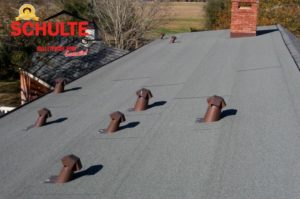The flat roof is a popular design because it effectively maximizes attic space. Many commercial and some residential buildings implement this design because of the extra space benefit; however, there is one well-known drawback with a flat structure – water leakage.
residential buildings implement this design because of the extra space benefit; however, there is one well-known drawback with a flat structure – water leakage.
Due to the flat design, any precipitation tends to pool and seep through cracks causing water to get inside the structure. Although the facts involving flat roofs and water leakage cannot be changed, early detection can make a big difference and hopefully eliminate the need for a costly renovation or replacement of the structure.
Manual Inspection
A manual inspection is the basic approach to detecting a leak. Any water breach in the top layer of the roof will leave physical traces such as stains and rust. The first tell-tale sign of a leak is brittleness of the finish. Most flat roofs make use of asphalt to cover the top of the building. Constant exposure of the roof top to the sun’s UV rays will eventually turn any material brittle and cracks could form that would serve as a point of entry for water seepage. When the asphalt crumbles easily, this is a sign that it will no longer provide sufficient protection from water and will probably require repair or replacement.
Signs of leakage could also be visible on the supporting structure beneath the roof. Dark stains along the ridges will indicate exposure to water as will rusty nails. In extreme cases, the interior ceiling and walls could develop stains due to the water seepage.
The conventional approach is to look for leaks by checking for signs such as stained ceilings and walls. At this point, extensive damage may have already occurred between the entire structure and the ceiling. There is currently used by contractors to detect leaks before extensive damage appears and that is infrared technology.
Infrared Technology
An infrared camera is used to survey the entire roof, checking for subtle differences in the temperature on the top of the structure. During the day, the sun will naturally heat the entire structure. As it begins to cool in the afternoon, any portion on the top of the building that has a leak will develop a high thermal mass due to the collection of moisture. These spots are very visible on an infrared camera. The variation of the thermal mass on the image that has been captured will help locate the specific area where leakage is occurring or beginning to develop.
Infrared scanning can be done by two different methods. The thermal image of a building can be captured from a distance to get the overall profile of the roof or by closely scanning every inch of the structure by walking on it with the thermal imaging device. This approach is often done along while visually inspecting the top and underside of the structure. Once a problem area is detected, it can be determined how to deal with the problem.
Safety Reminder
When conducting an inspection, it is important to be alert to the danger of working at heights. Even with a flat roof, there is still a risk of falling from it or collapsing if the structure is extensively damaged. Always wear rubber-soled shoes to avoid slipping when walking on a roof; a safety harness should also be worn to stop a fall.
Roof inspections should be done annually, particularly with a flat structure that is more prone to leaks. Part of keeping the building’s top surface in good condition and helping to extend its life can be accomplished by taking care of any small leaks that are found by patching them before they become severe and cause serious roof damage. Thanks to the usage of infrared technology, a leak can be detected at an early stage and repaired before shortening the life of the entire structure!
Are you looking for a Houston roofing repair contractor to look at your roof? Schulte Roofing of Navasota provides roofing services to the greater Houston area and can help Houston residents with all of their roofing problems!
